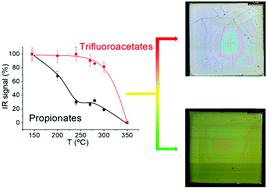当前位置:
X-MOL 学术
›
J. Mater. Chem. C
›
论文详情
Our official English website, www.x-mol.net, welcomes your
feedback! (Note: you will need to create a separate account there.)
Pyrolysis study of solution-derived superconducting YBa2Cu3O7 films: disentangling the physico-chemical transformations
Journal of Materials Chemistry C ( IF 5.7 ) Pub Date : 2020-07-01 , DOI: 10.1039/d0tc01846e Bohores Villarejo 1, 2, 3, 4 , Cornelia Pop 1, 2, 3, 4 , Sussagna Ricart 1, 2, 3, 4 , Bernat Mundet 1, 2, 3, 4 , Anna Palau 1, 2, 3, 4 , Pere Roura-Grabulosa 4, 5, 6 , Jordi Farjas 4, 5, 6 , Teresa Puig 1, 2, 3, 4 , Xavier Obradors 1, 2, 3, 4
Journal of Materials Chemistry C ( IF 5.7 ) Pub Date : 2020-07-01 , DOI: 10.1039/d0tc01846e Bohores Villarejo 1, 2, 3, 4 , Cornelia Pop 1, 2, 3, 4 , Sussagna Ricart 1, 2, 3, 4 , Bernat Mundet 1, 2, 3, 4 , Anna Palau 1, 2, 3, 4 , Pere Roura-Grabulosa 4, 5, 6 , Jordi Farjas 4, 5, 6 , Teresa Puig 1, 2, 3, 4 , Xavier Obradors 1, 2, 3, 4
Affiliation

|
Chemical solution deposition (CSD) of epitaxial YBa2Cu3O7 (YBCO) films is a high throughput, cost-effective approach to grow high critical current superconducting conductors for power applications. Achieving high critical currents requires to grow epitaxial films with large thicknesses and this is still an open issue in CSD. Metalorganic precursor solution deposition can be tailored to achieve high film thicknesses, however, the pyrolysis step may heavily compromise the film quality due to the in-plane stress generated by a strong film shrinkage. Here, we disclose the complex relationship existing during the pyrolysis process between the physico-chemical transformations and the microstructure of the films. A low-fluorine trifluoroacetate (TFA) and propionate (prop) route to YBCO films with a final thicknesses in the range of 700–800 nm was studied to understand the phenomena. Morphological analysis by in situ optical microscopy video imaging under specific heating rates allowed to identify the thermokinetic conditions leading to permanent or reversible wrinkling and crack formation. The origin of the microstructural transformations during the pyrolysis of thick films has been disentangled through parallel in situ analyses of the chemical, thermal and mechanical properties, together with film thickness measurements. A key finding has been the identification of an intermediate liquid phase relieving the compressive stress responsible of wrinkling. Disclosing the origin of the physico-chemical transformations opens the path towards defining optimized pyrolysis processing conditions for high quality single deposition of CSD films.
中文翻译:

溶液衍生的超导YBa2Cu3O7薄膜的热解研究:理化转变
外延YBa 2 Cu 3 O 7的化学溶液沉积(CSD)(YBCO)膜是一种高产量,具有成本效益的方法,可用于生产用于电源应用的高临界电流超导导体。要达到高临界电流,就需要生长大厚度的外延膜,这在CSD中仍然是一个未解决的问题。可以定制金属有机前体溶液的沉积以实现高膜厚,但是,由于强烈的膜收缩产生的面内应力,热解步骤可能会严重损害膜质量。在这里,我们公开了在热解过程中存在的物理化学转化和薄膜微观结构之间的复杂关系。研究了一种低氟三氟乙酸盐(TFA)和丙酸盐(prop)到YBCO薄膜的最终厚度为700-800 nm的范围,以了解这种现象。形态分析在特定加热速率下进行的原位光学显微镜视频成像可以确定导致永久或可逆起皱和裂纹形成的热动力学条件。通过对化学,热和机械性能的平行原位分析以及膜厚测量,已经解开了厚膜热解过程中微观结构转变的起源。一个关键的发现是确定了一种中间液相,该中间液相可以消除起皱的压应力。揭示理化转变的起源为定义用于CSD膜的高质量单次沉积的最佳热解工艺条件开辟了道路。
更新日期:2020-08-06
中文翻译:

溶液衍生的超导YBa2Cu3O7薄膜的热解研究:理化转变
外延YBa 2 Cu 3 O 7的化学溶液沉积(CSD)(YBCO)膜是一种高产量,具有成本效益的方法,可用于生产用于电源应用的高临界电流超导导体。要达到高临界电流,就需要生长大厚度的外延膜,这在CSD中仍然是一个未解决的问题。可以定制金属有机前体溶液的沉积以实现高膜厚,但是,由于强烈的膜收缩产生的面内应力,热解步骤可能会严重损害膜质量。在这里,我们公开了在热解过程中存在的物理化学转化和薄膜微观结构之间的复杂关系。研究了一种低氟三氟乙酸盐(TFA)和丙酸盐(prop)到YBCO薄膜的最终厚度为700-800 nm的范围,以了解这种现象。形态分析在特定加热速率下进行的原位光学显微镜视频成像可以确定导致永久或可逆起皱和裂纹形成的热动力学条件。通过对化学,热和机械性能的平行原位分析以及膜厚测量,已经解开了厚膜热解过程中微观结构转变的起源。一个关键的发现是确定了一种中间液相,该中间液相可以消除起皱的压应力。揭示理化转变的起源为定义用于CSD膜的高质量单次沉积的最佳热解工艺条件开辟了道路。











































 京公网安备 11010802027423号
京公网安备 11010802027423号